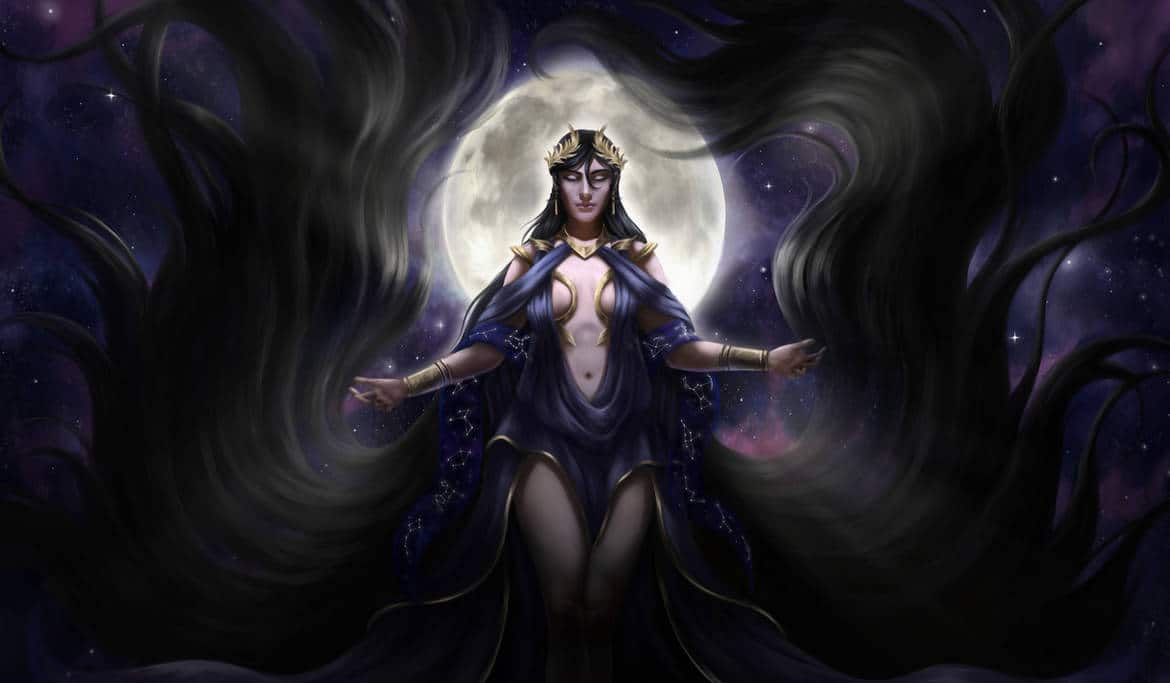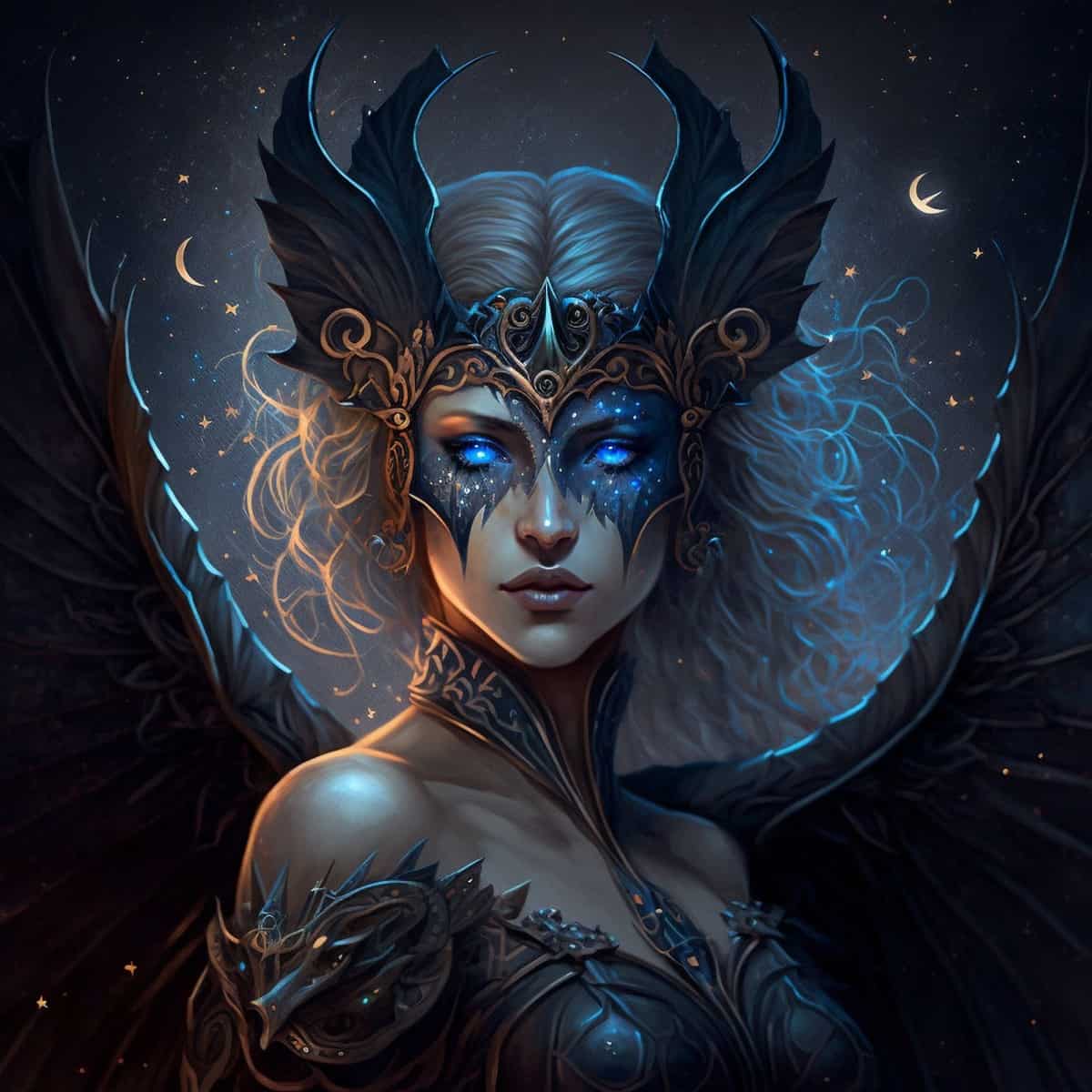Which came first, was it the chicken or the egg? This is the conundrum that most poets like to bring up whenever they talk about the ancient idea of primordiality.
But, if we were to dive deeper into past, we would stumble across a much more interesting question that has been plaguing philosophers since before time itself: Which came first, the night or the day?
Depending on which mythology you are to tackle, there are different answers that come to mind, but by far our favorite is the Greeks’ interpretation.
For them, this question is quite silly because the answer is very simple, before the reign of light, before the beginning of time itself, there was a goddess that was more beautiful than any other.
She ruled over the peaceful serenity of darkness, engulfing the world with her shadowy robe and giving meaning to an otherwise bleak and meaningless world.
Her name is Nyx and she is the Greek Goddess of the Night, the daughter of CHAOS and most importantly, the one who even the mightiest Gods fear.
The thing about Nyx though is that she’s not the type of goddess that you write about casually, because she almost never gets involved. She is the scenery; she is the all-powerful watcher that keeps tabs on everything and everyone.
She is never disturbed, because bringing forth the wrath of darkness is a quickfire way of losing your life, regardless of who you are or how powerful you may be.
Because of this, she very rarely is showcased in Greek mythology works or even Western literary pieces altogether.
We do have plenty of literary works on Eos, her sister, the Goddess of Dawn, but the only thing that we truly know about Nyx for a fact is that she is the mother of all, and she is not one to mess with.
She was born in Gaia, where she also gave birth to Hypnos, or the God of Sleep, Thanatos, the God of Death and Erebus, the God of Darkness.
While there aren’t too many stories about her as a goddess, we do have a few showcases of her power and might thanks to some surviving ancient Greek myths, including:
Nyx in Theogony

Hesiod actually was one of the few philosophers that tried to write about Nyx in his work “Theogony”. This is where he stated that Nyx gave birth to Aether (Brightness) and Hemera (Day) after a few escapades with Erebus.
Later on down the line however, she gave birth to the Moros, the Keres and Thanatos, alongside Hypnos, the Oneiroi, Momus, Oizys , the Hesperides, Moirai, Apate, Nemesis, Geras and Eris.
She was also known for having birthed Charon, Hades’ ferryman, the god that transported the dead over the river Styx.
But not all of her children were evil or monstrous, since she soon after also gave birth to Philotes, aka the Goddess of Friendship.
Many experts believe that this was done on purpose to showcase the fact that while friendship can be pure and just, it can also result in betrayal and pain.
According to Hesiod, she now resides in Tartarus alongside her sons Hypnos and Thanatos. As soon as her daughter Hemera (Day) makes her way into Tartarus though she leaves and she takes over until they swap places again.
This portrayal of the day and night cycle is actually very similar to that of Ratri in the Rigveda of India. In that mythology, there is a lot of tension between her and Ushas (Dawn), which is also visible in Greek mythology between Nyx and Eos.
Zeus Fears Nyx
When we think about Zeus, we like to think of him as the almighty god that rules over everyone else. He was the one that took on the Gods, the one destined to become their ruler from his very inception.
He was the one that rebelled against Cronus back in the day, and he even took on the other Titans, banishing them away to Tartarus and taking over the crown for himself.
Even so, this mighty God of Thunder and Lightning, this God of Gods, he feared the wrath of the Goddess of the Night above all else.
This was showcased in Homer’s Iliad, around 14.249 – 61, where he wrote that Hypnos, a deity of Sleep, was coerced by Hera to put Zeus to sleep as he had done before in the past.
He did so successfully in order to allow Hera to directly attack Heracles who had just returned by sea from Laomedon’s Troy.
Because of them bickering however, Zeus woke up prematurely, attacking Hypnos for attempting to put him to sleep.
Fearing for his life in the face of imminent danger, Hypnos thought himself to be a goner, having fled to the only place that he knew he’d be welcomed in even while chased by the killer of Gods himself.
He fled to his mother’s side, begging that she would save his life. As soon as Nyx showed up, Zeus stopped his advancements, looking up at the Goddess of the Night in awe.
Homer takes a second here to describe Zeus’s inner feelings, because even though he was quick to anger and he very rarely listened to others, he, for the first time in a very long time, feared the wrath of Nyx.
As such, he controlled his temper, turning his back to the Goddess of Night, walking away in shame knowing that a single word could be the death of him.
This is the story of Hypnos and how he escaped the clutch of the God of Thunder and Lightning, but it isn’t the only time that he would attempt this.
In other stories, he would try and put Zeus to sleep again several times over, but to no avail, and after every single mishap he would run back to his mother.
Every time Nyx would show up, Zeus would calm down and walk away. This is to show just how much respect Zeus has for Nyx, because even though he was constantly pestered by the minor deity, even he knew not to mess with the primordial Goddess of Night.
Nyx as the Mother of All Creation
Up until this point, Nyx was known as a primordial goddess that preceded the likes of Zeus and Hades, but her role would swiftly change as soon as these fragmentary poems attributed to Orpheus would come up.
This is where Nyx, instead of being showcased as just the mother of atrocities and monsters alike, she would be given the role of the first principle being from which all creation emerges.
Instead of just living in Tartarus with her sons, she now rests in a cave in which she issues oracles. She lives right outside of Cronus’s cage, where he is chained and asleep for all of eternity,
Next to this cage you can see Adrasteia, the Goddess of Inevitable Fate, as she clashes her cymbals and beats upon her tympanon (a traditional hard drum). While she does this, she moves the entire universe to the rhythm of Nyx’s chanting as she dances ecstatically for the dawn of a new day.
In this new iteration, Phanes, the hermaphrodite Orphic demiurge is the child or father of Nyx, it is unclear which of these roles he has per se.
Instead, what we do know is that her voice signals the beginning of every new day as she creates everything from scratch through her chanting. She is also known as the mother of Eros in this version, aka the God of Love.
In the philosophical poem of Parmenides, the poet talks about being transported to a strange palace unlike anything he’d ever seen before. A classic scholar by the name of Walter Burkert has stated that this is most likely the palace of Nyx.
Nyx as a Charioteer of the Sky
Literary depictions aside, what was Nyx actually described as? Well, the problem here is that it almost seems as though philosophers and poets were scared of writing about Nyx, since she was even feared by the Gods themselves.
As such, we don’t know of any temples that could have been raised in her name in the past. There have been two temples that were built in ancient times in the name of Eos, her sister, but sadly they didn’t make it to present day.
There are a few ancient images which depict Nyx though that survived over the years, including this beautiful terracotta vase from the Metropolitan Museum of Art in New York which is said to date as far back as 500 B.C.E.
In this drawing we can see the hero Heracles offering up a sacrifice to the god of the Sun, Helios. As his gift is received, we can see that Helios is not alone. Instead, he is accompanied by Nyx and Hemera, who are commonly referred to as the Goddesses of Night and Day.
In this depiction we can see the two riding horse-drawn chariots in opposite directions as soon as dawn breaks.
This is yet another instance in which we can see just how intricate the mythology system of the ancient Greeks was in the past. They created a ton of stories which would explain the unknown machinations of the natural world.
Nowadays we would just say that the day and night cycles are caused by the Earth’s rotation around the Sun, but in the past, you would show the Sun God looking down at the world as he takes over the Goddess of the Night’s role and makes way for the Goddess of the Day to step in.
In some depictions, the two Goddesses hate each other, which is why they always run away from one another, but in this instance, we can see the two saluting one another, meaning that the only reason as to why they’re passing by each other is because of their sense of duty to the order of things.
Even in this depiction, Nyx is covered in gauzy robes, and you can clearly tell that this is the Goddess of the Night that you’re seeing based on the dark cloud or mist that rests gently upon her head. Hesiod may have described her place as murky and dark but maybe to her this is calming and homely?
Was Nyx a Good Goddess or an Evil One?
Now that we know who Nyx is and most importantly, what she represents, we should know the answer to this question pretty easily right? Well, actually, it’s not that simple.
While most Gods tend to be pretty blatantly good or bad, this isn’t the case with Nyx as her depictions are quite rare and polarizing in what they present.
We can say that she is one of the most powerful beings around for sure, as she can put any creature, man or God alike, to death with ease. This was proven by Zeus’s reaction to seeing her with his own eyes.
Nyx is by far the oldest Goddess that is still around, and Zeus knew that. The older the God is, the more feared they are. He had his bout with Cronos, but he would not dare overstep his authority in her domain.
She lived in Tartarus, a dark and desolate place in which suffering and torment are as natural as breathing and eating are for us. Even so, she is never depicted as downright evil in Greek mythology, quite the contrary actually.
We would argue that she is one of the nicest Goddesses around, regardless of which iteration of her you speak of.
She is the mother of a lot of atrocities, yes, but she never committed any of these atrocities herself. Take Zeus for example, he has plenty of devoted followers even to this day, and yet he committed more evil deeds than most other Gods combined.
Even so, she is most often times depicted as an evil Goddess due to her mysterious and dark nature. It is the same case as that of Hades, where just because he resembles the common day depiction of Lucifer, he is by far one of the least evil Gods around.
In her most popular depiction, she marries Erebus, the God of Darkness, and the two end up producing Hemera and Aether, aka the Gods of Day and Light.
Nyx and Hemera are polar opposites of one another, so as soon as the night comes, Nyx puts her dark veil over the night, and as soon as her time is over Hemera brings the warmth of daylight to clear out the dark mists left behind by Nyx.
She is a mother figure that will protect her children even against the strongest Gods around. She is a primordial mother that would even step up against the likes of Cronos if they were to attack her children for sure.
As such, if we were to make an educated guess, we would say that Nyx is not an evil Goddess, quite the contrary actually. She may be one of the nicest Goddesses in Greek mythology.
She spreads her wings of darkness over the realms of men and women alike, bringing them into the sweet embrace of Hypnos, or the God of Dreams.
Conclusion

Even though she is by far one of the most interesting depictions of what lived before the dawn of time itself, there was never all that much written about the Goddess of Night.
Many believe that this is because the poets feared her, but regardless of what their reason was, what we do know is that this lack of texts led to her not being as worshipped as we would have expected such a powerful Goddess to be,
She never had a cult of her own, and she never even had any temples risen in her name. Instead, other cults would bring up her name in their passing scriptures.
For example, she used to have a statue that was dedicated to her in the Temple of Artemis, which you can find at Ephesus.
Many still think that this is because she was actually the closest depiction to Lucifer, or more specifically to Lilith, the mother of all demons from Christianity.
This is largely untrue though, as the only real correlation between them is the fact that she is always represented in a dark fashion. This isn’t to say that she is pure or anything of that sort, but she was never shown as an evil being, not by a longshot.
Regardless of whether she was there to create the universe or if she was in the background the whole time, minding her own business, we still have to say that she is one of the most interesting Goddesses in the Greek mythology, and by far one of the most interesting reads if you ever have the time for it.
She was so powerful that even the mightiest gods around feared her, and if that’s not enough of a reason to respect her, we don’t know what is.













